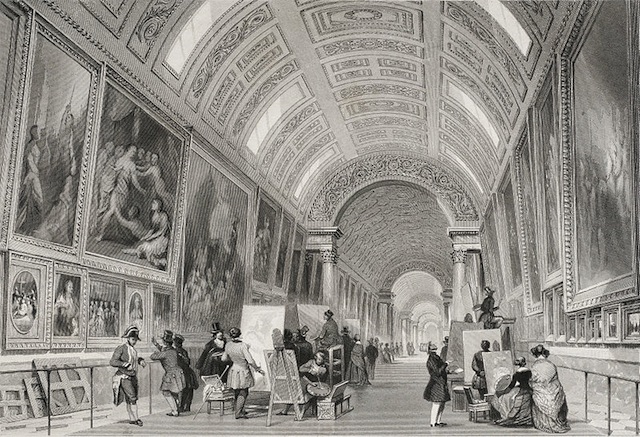
Did you know that the encyclopedists wanted to open up the gardens and galleries of the Louvre Palace to the public long before it was slated to become a museum? The Palais du Louvre was constructed in 1190 by Philippe Auguste as a fortress to protect against Norman invasions. It was home to François Ier during the Renaissance. Henri IV built the Grand Gallery connecting the royal apartments in the Louvre to the Tuileries palace. The Louvre as it appears today was completed under Louis XIV, with additions by Louis XV. But it was only after the French Revolution that the Louvre was finally converted from a royal residence to the museum we know and love today. But over a decade before the Revolution, when Diderot and D’Alembert were compiling the Encyclopedia, their entry for the Louvre not only tells the palace’s history but makes some suggestions for its use that were rather advanced at the time:
The completion of this majestic edifice still remains to be desired. One would hope, for example, that all the ground floors of this building would be cleaned and re-established as porticos. It would serve these porticos to arrange all the most beautiful statues of the kingdom, to assemble these sorts of precious works dispersed in the gardens where no one walks anymore and where the air, the weather and the seasons wastes and ruins them. In the part situated in the middle, one could place all the paintings of the king, which are now stacked and mixed up together in the closets where no one enjoys them. One could put in the north the gallery of maps, if there’s no obstacle there. One would also transport in other places in the palace, the cabinets of Natural history and that of medals.
The side of Saint Germain l’Auxerrois free and disengaged, would offer to everyone views of this beautiful colonnade, a unique work, which citizens would admire and foreigners would come to see.
The different academies would assemble here in rooms more comfortable than the ones they occupy today; finally one would form various apartments to house academicians and artists. That is, as one says, what it would be nice to do with this vast edifice, which in two centuries might offer nothing more than debris. M. de Marigni has since hardly executed the most important of these things, the conservation of the building.
The author rightly predicts that if opened up to the public, French citizens and foreigners would flock to see the architectural masterpiece of the Louvre. Dubbed the Central Museum of the Arts, the Louvre opened its doors to the public on August 10, 1793. Admission was free, but preference was given to artists. The general public was only admitted on weekends.
Ironically, the victors of the French Revolution found that the greatest works of art were created to celebrate the French aristocracy. They were torn between destroying the symbols of the nobility they had just overthrown and preserving the works of some of the greatest artists who ever lived. Luckily, those paintings and sculptures survived, but that would not be the last time they were threatened by political upheaval. Still, had Diderot lived to see the Louvre become a museum, he would have been satisfied to know that access to artistic masterpieces was taken out of the hands of the aristocracy and made available to all citizens and foreigners alike.
Except from the Encyclopedia translated from the French by the author. Get in touch with the author @lauraitzkowitz.





